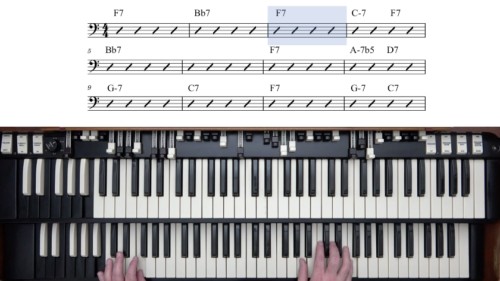Turnarounds & Connecting Phrases
In this lesson we will examine the slight variations on the A Sections and we will then learn how to connect the A & B Sections together using turnarounds.
Visualising The Form
When playing through tunes it’s useful to have a mental visualisation of the form. In this case the form is AABA, each block represents a bar and this approach makes it easy to visualise and memorise the harmony for the tunes that we are working on.
Pay attention to the slight variations in the melody on the 2nd line of each A Section, and also notice how I connect each section with chord voicings and melodic decoration in the full demonstration.
Connecting The A Sections
We explore a number of ways to navigate the turnaround from the 1st A Section to the 2nd A Section. Looking at the lead sheet we have a long tied note where the melody is static. We can outline the stride left hand but this can sound a little plain and so we explore the following options:
- F major blues scale fragments
- Blues licks & riffs
- Octave tremolo combined with blues licks
Transitioning Into The B Section
The transition from the 2nd A Section to the B Section is a little more complicated because we need to modulate to the relative minor D Minor. We add a cliché blues turnaround and a 25 progression to the relative minor (E-7b5 & A7) to navigate this important section of the tune.
Ending The Tune
Finally we explore a signature blues ending with can be used to end the tune, to start the tune again, or to head into an improvised solo. The voicings for the turnaround phrase are:
- Fmaj / Adim / Bb / Bdim7 / F/C / Db9 / C9#5 / F
In the next lesson we will explore passing chords, I’ll see you there.
Lesson Downloads
-
Georgia Harmonic Visualisation File Type: pdf
-
Turnarounds Full Demonstration File Type: pdf
-
Bluesy Turnaround Variations File Type: pdf
-
Soulful Turnaround Variations File Type: pdf
Practice Tips
-
Practice the A and B sections equally and ensure that you are devoting enough time to the 8 bar B section.
-
Learn the different turnaround options so that you have the creative freedom on how to play the turnaround phrases.
-
Listen to lots of recordings and study how the musicians connect the different sections with melodic and harmonic fills.









Thanks for all these tips!
It would be great if you could you write down some of these licks, so we can remember (and practice) them easier without having to scroll through the videos.
Hi Laurent 👋
Thanks for the comment and I’m glad to hear you are enjoying the course.
Yes I will create some notation of the licks, another students has asked for this so it is on my to-do-list.
I have just added another lesson to this course and another one will be added tomorrow. I have more lessons in the editing stage covering intermediate/advanced arranging techniques, and finally I will be adding a whole module on improvisation.
Be sure to attend my seminar next Friday where we will explore this tune and the possibilities for improvisation, you can register here: pianogroove.com/live-seminars/georgia-deep-dive-analysis/
Cheers,
Hayden
Hi Laurent,
I have just added the PDF downloads for this course.
All demonstrations: licks, riffs, turnarounds, passing chords, etc.. have been notated.
Cheers,
Hayden
I’ve been playing around with the final turnaround. It descends to the Eb in the A0 then to the D in Bb chord. It feels like it should move to the Db in the B0 chord rather than stay at D. I played an Ab-D-F in the right hand against the B in the left hand. I guess that would be a B#9b5 chord? Or is that just a B-b5? Curious for your thoughts.
Whoops. I play Ab-Db-F in the right hand. That would be a B9b5, I think.
B13b5? Figuring chords out is complicated!
Hey Gib,
Sorry for the late reply here.
The chord that you outline is simply a diminished 7th chord.
B in the left hand, and Ab, D, and F in the right hand.
We could look at this as a Bdim7 chord which is used to approach the F/C chord.
The same notes (B-D-F-Ab) can function as 4 different diminished chords, as the chord is symmetrical when we invert it up the keyboard. If we play those 4 notes and then add a G in the bass, we have a G7b9, which is why this voicing can be used to approach the F/C chord. If we change the G in the bass to a Db, we then have a Db7b9 chord (the tritone relationship).
Diminished chords are very interesting chord structures, we have 3 forum threads here with lots of information:
community.pianogroove.com/t/all-about-diminished/3179
community.pianogroove.com/t/diminished-scale-theory/1675
community.pianogroove.com/t/diminished-fully-and-half-vs-ii-7b5/8290
Take a read over those threads and it should give you lots of additional insights.
Cheers,
Hayden